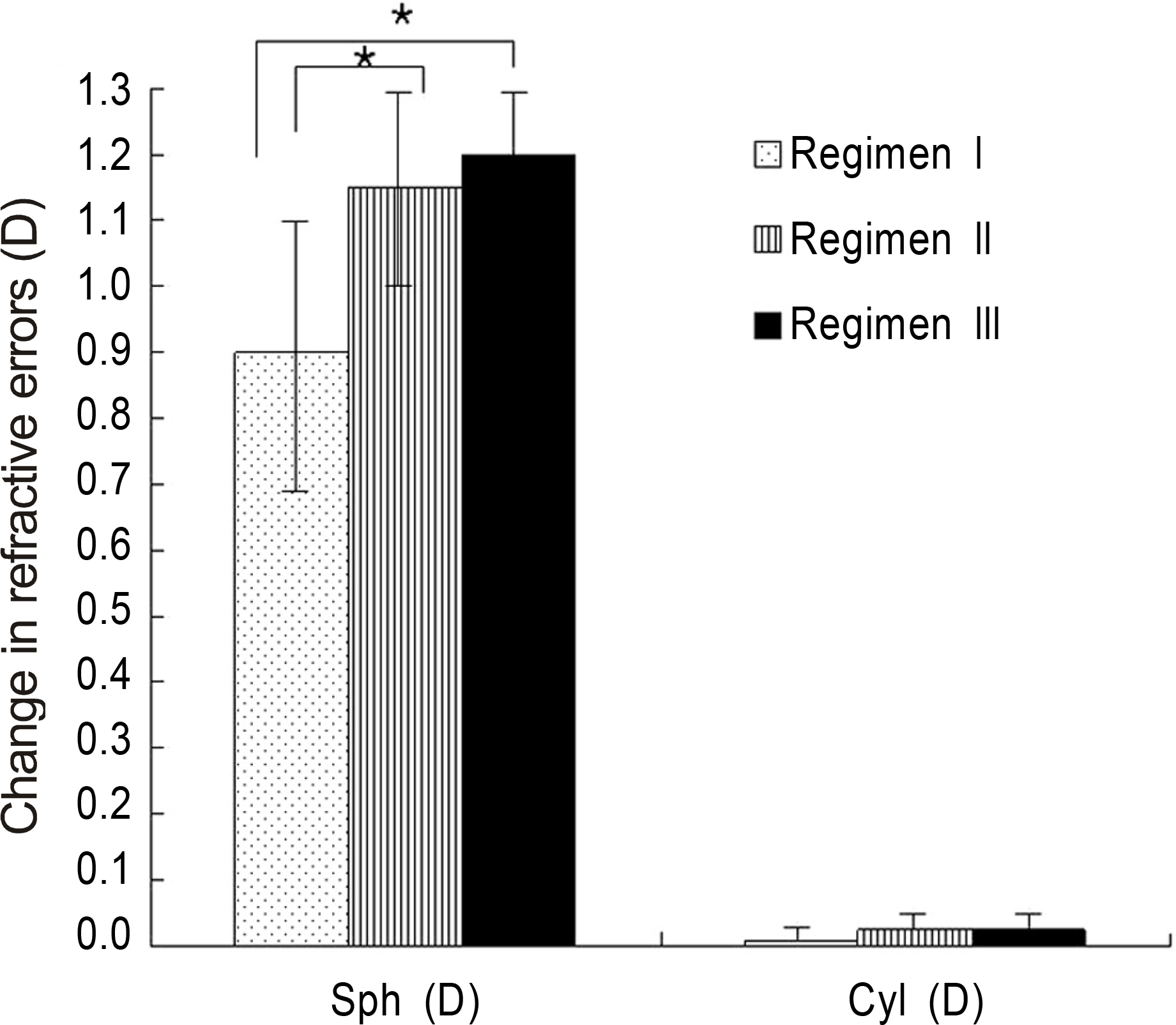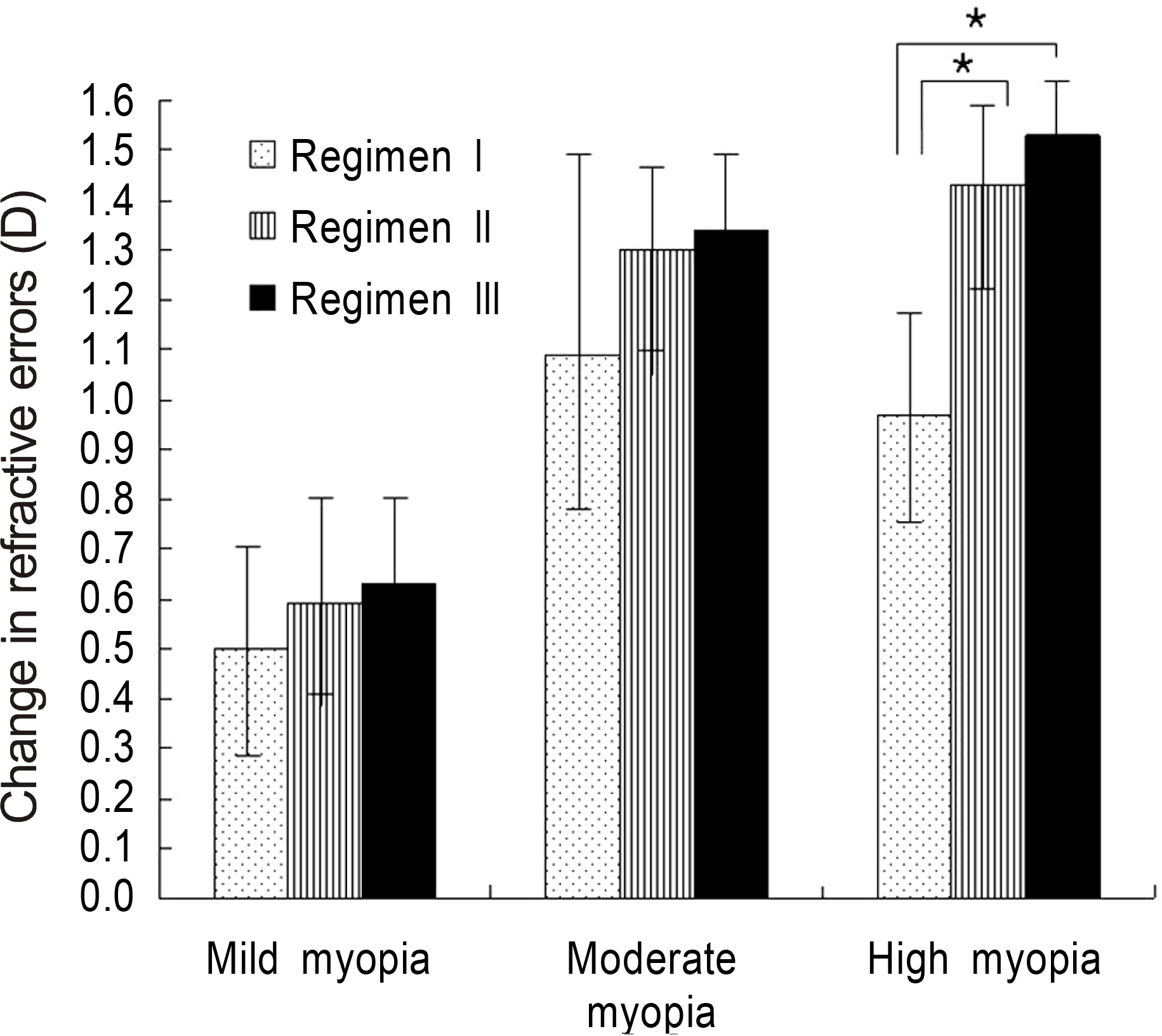J Korean Ophthalmol Soc.
2011 Feb;52(2):141-146.
Comparative Study on the Efficacy of Different Cycloplegic Agents in Myopic Adults
- Affiliations
-
- 1Department of Ophthalmology, Myongji Hospital, Kwandong University College of Medicine, Goyang, Korea. mingming8@naver.com
- 2The Institute of Vision Research, Department of Ophthalmology, Yonsei University College of Medicine, Seoul, Korea.
Abstract
- PURPOSE
To evaluate the efficacy of 3 cycloplegic regimens in adults with myopia.
METHODS
Refraction, accommodation amplitude, residual accommodation and biometric findings were assessed before and after instillation of regimen I (tropicamide 0.5% and phenylephrine 0.5%), regimen II (cyclopentolate 1.0%), and regimen III (combination of regimen I and II).
RESULTS
In myopic adults aged 22 to 26 years, cycloplegic refraction revealed less myopia than manifested refraction. Although there was no difference in residual accommodation among the 3 regimens, regimen II and III were more effective in reducing myopia, accommodation, and axial length. The difference in cycloplegic refraction between regimen I and II was more prominent in patients who had larger amplitude of accommodation and residual accommodation with regimen I.
CONCLUSIONS
Cycloplegic refraction should be used even in adult myopes. For patients with stronger accommodation and larger residual accommodation with tropicamide, cycloplegic refraction with cyclopentolate may be used to ensure relaxation.
MeSH Terms
Figure
Reference
-
References
1. Moon NJ, Kim JC, Koo BS. The study on the necessity of cycloplegic refraction in school children. J Korean Ophthalmol Soc. 1988; 29:377–85.2. Kim CK, Hong SH. Changes in refractive finding after using cycloplegics in young adult. J Korean Ophthalmol Soc. 1984; 25:341–5.3. Bannon RE. The use of cycloplegics in refraction. Am J Optom Arch Am Acad Optom. 1947; 24:513–68.
Article4. Maoury SD. Comparison of fixation targets during noncycloplegic retinoscopy. Am J Ophthalmol. 1967; 63:865.
Article5. Hiatt RL, Braswell R, Smith L, Patty JW. Refraction using mydriatic, cycloplegic, and manifest techniques. Am J Ophthalmol. 1973; 76:739–44.
Article6. Hofmeister EM, Kaupp SE, Schallhorn SC. Comparison of tropicamide and cyclopentolate for cycloplegic refractions in myopic adult refractive surgery patients. J Cataract Refract Surg. 2005; 31:694–700.
Article7. Yang SW, Lee NY, Kim SY. The effect of cycloplegia on vision and stereopsis: comparison between before and after cycloplegia. J Korean Ophthalmol Soc. 2006; 47:1454–8.8. Rosenfield M, Cohen AS. Repeatability of clinical measurements of the amplitude of accommodation. Ophthalmic Physiol Opt. 1996; 16:247–9.
Article9. Atchison DA, Capper EJ, McCabe KL. Critical subjective measurements of amplitude of accommodation. Optom Vis Sci. 1994; 71:699–706.10. Gettes BC, Leopold IH. Evaluation of five new cycloplegic drugs. AMA Arch Ophthalmol. 1953; 49:24–7.
Article11. Lancaster WZ, Williams ER. New light on the theory of accommodation with practical application. Trans Am Acad Ophthalmol Otolaryngol. 1914; 19:170–95.12. Ciuffreda KJ. Near work- induced transient myopia: basic and clinical aspects. J Optom Vis Dev. 1999; 30:5–20.13. Ciuffreda KJ, Wallis DM. Myopes show increased susceptibility to nearwork aftereffects. Invest Ophthalmol Vis Sci. 1998; 39:1797–803.14. Ciuffreda KJ, Lee M. Differential refractive susceptibility to sus-tained nearwork. Ophthalmic Physiol Opt. 2002; 22:372–9.
Article15. Wolffsohn JS, Gilmartin B, Thomas R, Mallen EA. Refractive error, cognitive demand and nearwork-induced transient myopia. Curr Eye Res. 2003; 27:363–70.
Article16. Duane A. Studies in monocular and binocular accommodation with their clinical applications. Trans Am Ophthalmol Soc. 1922; 20:132–57.
Article17. Priestley BS, Medine MM. A new mydriatics and cycloplegic drug. Compound 75 G. T. Am J Ophthalmol. 1951; 34:572–5.18. Gordon DM, Ehrenberg MH. Cyclopentolate hydrochloride: a new mydriatic and cycloplegic agent; a pharmacologic and clinical evaluation. Am J Ophthalmol. 1954; 38:831–8.19. Miranda MN. Residual accommodation. A comparison between cyclopentolate 1 percent and a combination of cyclopentolate 1 percent and tropicamaide 1 percent. Arch Ophthalmol. 1972; 87:515–7.20. Stine GT. Clinical investigation of a new cycloplegic and mydriatic drug. Eye Ear Nose Throat Mon. 1960; 22:11–4.21. Milder B. Tropicamide as a cycloplegic agent. Arch Ophthalmol. 1961; 66:70–2.
Article22. Choi O, Choo CH, Cho SC. The studies on the residual accommodation of Koreans. II. The residual accommodation under 0.5 percent scopolamine and 1 percent cyclogyl cycloplegia. Yonsei Med J. 1964; 5:62–4.23. Ebri A, Kuper H, Wedner S. Cost-effectiveness of cycloplegic agents: results of a randomized controlled trial in Nigerian children. Invest Ophthalmol Vis Sci. 2007; 48:1025–31.
Article24. Choi YH, Choi YY. The difference comparison according to child refractive method and effect of life style on myopia. J Korean Ophthalmol Soc. 2005; 46:1841–7.25. Gao L, Zhuo X, Kwok AK, et al. The change in ocular refractive components after cycloplegia in children. Jpn J Ophthalmol. 2002; 46:293–8.
Article26. McBrien NA, Moghaddam HO, Reeder AP. Atropine reduces experimental myopia and eye enlargement via a nonaccommodative mechanism. Invest Ophthalmol Vis Sci. 1993; 34:205–15.27. Luft WA, Ming Y, Stell WK. Variable effects of previously un-tested muscarinic receptor antagonists on experimental myopia. Invest Ophthalmol Vis Sci. 2003; 44:1330–8.
Article28. Gwiazda J, Marsh-Tootle WL, Hyman L, et al. Baseline refractive and ocular component measures of children enrolled in the correction of myopia evaluation trial (COMET). Invest Ophthalmol Vis Sci. 2002; 43:314–21.29. Saw SM, Chua WH, Hong CY, et al. Nearwork in early-onset myopia. Invest Ophthalmol Vis Sci. 2002; 43:332–9.30. Kim JC, Koo BS. A study of prevailing features and causes of myopia and visual impairment in urban school children. J Korean Ophthalmol Soc. 1988; 29:165–81.
- Full Text Links
- Actions
-
Cited
- CITED
-
- Close
- Share
- Similar articles
-
- Statistic Observation About Effect of Cycloplegic Refraction in Primary School Children
- Study on Lens Thickness and Anterior Chamber Depth during Accommodation and Weak Cycloplegic Eyes
- Refraction before and after LASIK
- Refractive State in Childhood with Normal Visual Acuity
- Transient Myopic Shift Due to Increased Latent Accommodation after LASEK



